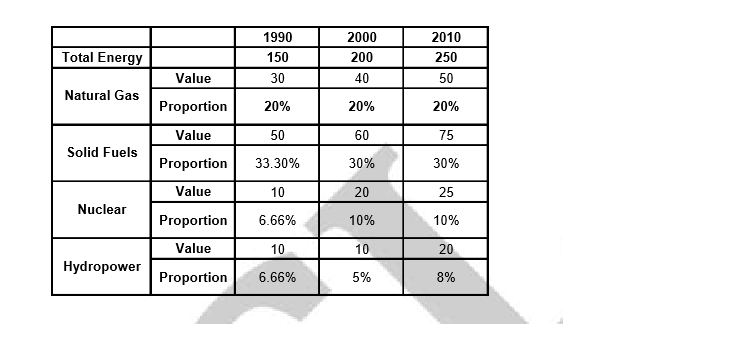CAT 1993
Ans .
(d) BACD
- Explanation :
B. starts at the beginning of Indian industrialization, A. elaborates on it, C. talks about the scenario today, D. states a common element between the beginning and today. The word ‘However’ in D makes it the conclusive statement AC is mandatory pair. Thus option D (BACD) is the best option.
Ans .
(c) ABCD
- Explanation :
c The correct sequence is ABCD. The question in (1) is answered by A. B follows A by talking about how the state spies upon the taxpayers. C follows B and likens the state’s possible behavior to what the tax authority tries to do inconsistently. D talks about an Orwellian System (a despotic form of government described in Orwell’s novel 1984) thereby linking it to sentence 6.
Ans .
(c) ABCD
- Explanation :
C. makes a comparison between competition and justice. D. states what the choice is ‘not between’, and B. by using ‘rather’ shows that it should follow D. A continues with the idea and leads to 6. Also DB is a mandatory pair and hence, we are left with only one option i.e. A.
Ans .
(a) BCAD
- Explanation :
a A. uses ‘thus’ to show the effect of the disparities in Yugoslavia mentioned in B. and C. It should thus follow the two. D. uses the phrase ‘will also’…, thus showing that it should follow A.
Ans .
(b) ABCD
- Explanation :
b The use of ‘these measures’ in A. refers to the measures stated in 1., so it should be the first sentence in the series. B talks about the objectives of these measures and C. and D. elaborate on the idea.
Ans .
(a) DACB
- Explanation :
a D. introduces the problem related to petroleum products, A. presents statistics to support it. B. talks about electricity, an idea which is continued in 6., so B. should be the last sentence in the series.
Ans .
(b) ABDC
- Explanation :
b A. starts at the beginning of the last 45 years, B. states how external powers tried to control the region, D. continues with the idea. C. talks about supply of arms to Pakistan, an idea that is continued in 6.
Ans .
(c) CBDA
- Explanation :
c C. states a cause for the problem introduced in 1. B. starts with ‘added to this’, showing that it should follow C. A. introduces a way out of the situation and 6. analyses the solution. Therefore A. should precede 6.
Ans .
(c) ADCB
- Explanation :
c A. introduces us to Rumford’s experiments, D. tells us about his observations. C. introduces the term ‘caloric’, B. explains the term.
Ans .
(d) CABD
- Explanation :
d C. introduces a controversy regarding ‘recognition’, A. states an aspect of that controversy, B. talks about what happens when an object is encountered and D. talks about what happens when the same object is countered again. BD is a mandatory pair and D has to be the sentence that makes a pair with sentence 6.
Ans .
(a) DCBA
- Explanation :
a D. continues with the idea introduced in 1. C. states an explanation about the phenomenon, B. refers to this explanation and A. states how it was substantiated. Also A will be the last sentence as it forms a mandatory pair with sentence 6.
Ans .
(a) BDCA
- Explanation :
a There are two mandatory pairs in the questions. BD and A6. B. talks about the beginning of evolution changes, D. about adaptations, C. about further improvements as well as about extinctions, and A. about the approach towards modern lines.
Ans .
(c) ABDC
- Explanation :
c A. states that what has been predicted annually, according to 1. has not happened. B., and then D., talk about events that led to such a prediction. The use of ‘then’ in D. shows that it should follow B. C. makes a statement that is analysed in 6.
Ans .
(c) CADB
- Explanation :
c C. introduces the topic of the passage, A. and D. explain it, B. presents the Economists’ view of the whole idea.
Ans .
(a) ABCD
- Explanation :
a A. introduces the view of realists regarding reality, B. refers to ‘this reality’ and should follow A. C. refers to the realists again by using ‘they’ and should follow A. and B. D. presents the author’s view about the given position.
Ans .
(d) ADCB
- Explanation :
d A. introduces ‘changes in demands’ as the topic sentence, D. gives some factors leading to the changes, C. elaborates on them and B. shows the effect of some more factors on the same issue.
Ans .
(c) BACD
- Explanation :
c B. talks about the positive aspect of India’s technological front, A. continues with the same, C. introduces the other side of the issue by using ‘but’ and D. contradicts C. by giving certain examples.
Ans .
(a) DCBA
- Explanation :
a D. introduces the topic of destruction of enemy kingdom by conquerors, C. uses the pronoun ‘he’ thus should follow D., B. and A. present more methods adopted by the conqueror in destroying the enemy.
Ans .
(b) CADB
- Explanation :
b C. introduces the idea of various industries offering services through millions of firms, A. states that the individual firms vary in size, D. talks about other variations and B. about the variations in policies etc. within the firms.
Ans .
(a) yellow
- Explanation :
a The colour of the Norwegian’s house is yellow
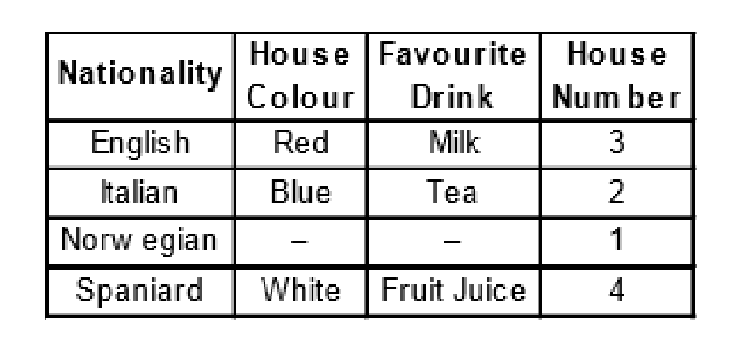
Ans .
(b) English
- Explanation :
b Milk is drunk by the Englishman.
Ans .
(b) cocoa
- Explanation :
b The Norwegian drinks Cocoa.
Ans .
(d) The Italian lives next to the Spaniard.
- Explanation :
d The only statement that is not true is (d), as the Italian lives in house no. 2 and the Spaniard lives in house no. 4, which are not next to each other.
Ans .
(b) Mathew
- Explanation :
b Let us assume that John’s first statement is true. So his second statement must be false. This implies that Mathew did it. This makes Mathew’s first statement false. So the second statement has to be true. This implies that Krishna didn’t do it. So Krishna’s first statement is true and his second statement is false. Since all the statements are consistent with each other, the assumption made by us should be the correct one. So it is Mathew who stole the boat.
Ans .
(b) Koik is the pilot.
- Explanation :
b The key here are the statements made by Koik. Since we know that he is wearing a cap, if his first statement is false, then his second statement cannot be true. So his first statement is true and his second statement is false. This implies that Koik is the priest. This makes Lony’s second statement false and so his first statement is true. So Lony is Koik’s son. This makes Mirna’s second statement false and so his first statement is true. So Lony’s father is a pilot. Thus, Koik is the pilot.
Ans .
(a) Left road takes you to the village
- Explanation :
a The first statement of Ram is obviously false, as he is saying that he never speaks to a stranger, when he actually is. So he must be new to those parts. This makes the second statement of Lila false. So she should be married to Ram. This makes the first statement of Laxman false. So the left road should take you to the village.
Ans .
(b) Bobby
- Explanation :
b If you observe Charle’s statement carefully, you will figure out that his first statement is true and second statement is false. For instance, if his first statement is false, then his second statement cannot be true. There would be inconsistency in what he is talking. So Charles is not the chief. This makes Bobby’s second statement false and first statement true. So Bobby is Amar’s father and hence, Amar’s first statement is false. So his second statement must be true. This implies that the chief is wearing the red shirt. So Bobby is the chief.
Ans .
(b) In the nuclear age, our mind-made world has been found flawed and dangerous, even lethal,
- Explanation :
b What follows the blank shows that what has been happening till now has led to some undesirable consequences and hence a change is now coming in. Therefore, option (b) is the only choice that shows what wrong has happened.
Ans .
(b) In the nuclear age, our mind-made world has been found flawed and dangerous, even lethal,
- Explanation :
b What follows the blank shows that what has been happening till now has led to some undesirable consequences and hence a change is now coming in. Therefore, option (b) is the only choice that shows what wrong has happened.
Ans .
(c) Casting the opposite as weaker than it really is, is not a very effective strategy.
- Explanation :
c c. suggests that the strategy adopted by some people is not very effective, and the idea is continued with in the passage when the author refers to it as ‘this fallacy’.
Ans .
(b) Is the argument truly fair to animals?
- Explanation :
b What follows the blank shows that the author is against the argument projected in the beginning of the passage. B. is the only choice which would support this.
Ans .
(a) Each person argues his or her position most sincerely.
- Explanation :
a The passage begins with the situation of two people on two different sides of the issue. Each gets a chance to argue his or her position and after listening to each other they decide whether they wish to change their position or not. The use of ‘then’ after the blank shows that some action has taken place before it, and (a) is the only option showing an action.
Ans .
(d) Sports car : Automobiles
- Explanation :
d A brand is a type of product and a sports car is a type of an automobile.
Ans .
(b) Art : Connoisseur
- Explanation :
. b A gourmet is an expert on food and a connoisseur is an expert on art.
Ans .
(a) Black : White
- Explanation :
a North is the opposite of south and black of white.
Ans .
(d) Training : Skill
- Explanation :
d Drought and famine are synonyms as are training and skill.
Ans .
(a) Nitty : Gritty
- Explanation :
. a Nuts and bolts are used together as a phrase just as nitty-gritty are also used together.
Ans .
(b) Cow : Bovine
- Explanation :
b Salty is the adjective for the noun ‘salt’. Bovine is the adjective for the noun ‘cow’.
Ans .
(a) Order : Chaos
- Explanation :
a Lack of being just is the defining characteristic of arbitrary just as lack of having order is a characteristic of chaos.
Ans .
(d) Homicide : Penalty
- Explanation :
d A crime leads to punishment, just as a homicide leads to a penalty.
Ans .
(c) Aircraft : Jet
- Explanation :
c Stratosphere is a layer of atmosphere, jet is a kind of an aircraft.
Ans .
(c) Fission : Fusion
- Explanation :
c The first word of both the pairs implies ‘to cut or break up something into parts’ while the second word in both means ‘bringing things together’.
Ans .
(d) Quotation
- Explanation :
d All others relate to payments made for something.
Ans .
(d) Bark
- Explanation :
d Equestrian means of or pertaining to horseback riding. Neigh is the cry of a horse. A derby is an annual horse race. Bark is the odd word out.
Ans .
(d) Adept
- Explanation :
d All others are synonyms.
Ans .
(d) Write
- Explanation :
d All others are nouns, while write is a verb.
Ans .
(c) Material
- Explanation :
c All others are synonyms.
Ans .
d The correct tag question should use the same auxiliary verb as in the main clause, hence the correct tag question here would be, ‘did you?’.
- Explanation :
(d) Isn’t it?
Ans .
(b) Rajan in leaving the
- Explanation :
b The correct idiomatic usage is ‘prevented someone from leaving’.
Ans .
(d) you had asked for it.
- Explanation :
d The ‘documents’ are a plural noun, so should be referred to by them and not it.
Ans .
(a) Who have you
- Explanation :
a Here who is acting as an object for the verb invited, hence should be replaced by ‘whom’
Ans .
(c) c
- Explanation :
From statement I: 2X +< 2Y 40 +≤or X +Y≤ 20
This statement alone cannot give the value of X. From statement II: X -2Y 20 −≥ This statement also alone cannot give the value of X. On combining statements I and II: Multiplying the second statement by –1 and adding both the statements, we get 3Y- 0 ≤ i.e., Y 0, ≤ but it is given that Y is non negative. ∴Y = 0 and X = 20 Hence, using both statements together we can answer the question.
Ans .
(c) c
- Explanation :
c From statement I: (a, b) can be (1, 8), (2, 4), (4, 2) and (8, 1). Therefore, statement I alone cannot give the value of a, b and c. From statement II: (b, c) can be (1, 9), (3, 3) and (9, 1). On combining statements I and II: b = 1, a = 8 and c = 9 Hence, the answer is (c).
Ans .
(a)
- Explanation :
Ans .
a If the numbers are a, b, c and d such that a < b < c < d, then from statement I, we get (d – c) > (b – a). So we can say, (d + a) > (b + c) or (d + a) + (d + a) > (b + c) + (d + a). Dividing both the sides by 4, we get (d + a) (a + b + c + d) > . 24 This shows that the average of the largest and the smallest of four numbers is indeed greater than the average of all the 4 numbers. Hence, we can answer the question using statement I only.
Ans .
(d)If the question cannot be answered even with the help of both the statements.
- Explanation :
d From statement I, the ages could be either (1, 3, 7) or (1, 1, 21). Statement II doesn’t simplify this further as none of the above combinations when added is divisible by 3. Hence, the answer is (d).
Ans .
(c)If both, statement I and statement II are needed to answer the question
- Explanation :
c From statement I: From this statement, exact number of widgets produced by machine A cannot be determined. From statement II: From this statement also exact number of widgets produced by machine A cannot be determined.
Ans .
(a)If the question can be answered with the help of statement I alone
- Explanation :
a From statement I: We can say that the perimeter of the hexagon is 36 cm, or the length of each side is 6 cm. From this we can find its area. So this statement alone is sufficient to answer the question. From statement II: It does not provide any other data, but merely states the property of a regular hexagon. So, this statement alone is not sufficient to answer the question.
Ans .
(c)If both, statement I and statement II are needed to answer the question
- Explanation :
c From statement I: Let price per kg of mangoes be Rs.x and price per dozen of oranges be Rs.y. ∴10x + 2y = 252 From this statement, we cannot find x. From statement II: 2x = y From this statement also, we cannot find the price per kg of mangoes. On combining statements I and II: 14x = 252 i.e., x = 18 Hence, using both statements together we can answer the question.
Ans .
(c) Rs.15
- Explanation :
c The two equations are : 2o + 3b + 4a = 15 and 3o + 2b + a = 10. Adding the two equations, we get 5o + 5b + 5a = 25 ⇒ o + b + a = 5 ⇒ 3o + 3b + 3a = 15.
Ans .
(c) Rs.24.20
- Explanation :
c Since the inflation rate is 8% in both the years 1994 and 1995, therefore, the rate of increase of the price of sugar is 10%. ∴Price of sugar on January 1, 1996 = Price of sugar on January 1, 1994 ×(1+(10/100)2) = 20 ×1.21 = Rs.24.20 per kg.
Ans .
(c) 80
- Explanation :
c Total number of two digit codes that can be formed is 10 × 10 = 100 Out of them 0,1,6,8,9 can create confusion. Using these five digits, total number of two digit numbers that can be made is 5 × 5 = 25. But out of these 25 numbers 00,11,88,69 and 96 will not make any confusion. Hence, the required answer is 100 – 25 + 5 = 80.
Ans .
(a) This is never possible.
- Explanation :
. a It can be very easy to figure out that (x + y) will always be greater than xy, only if one of them is 1. E.g. If x = 1 and y = 2, then (x + y) = 3 and xy = 2. Hence, (x + y) > xy. Other than this, for all other values of x & y, (x + y) will always be less than xy, and hence, the ratio of (x + y) < 1, xy and hence, cannot be an integer. Also, even if one of the values is 1, (x + y) xy will never be an integer. Hence, the answer is (a).
Ans .
(d) z^2 (x4 + y4)/2 is even
- Explanation :

Ans .
(c) 138
- Explanation :
c There are 139 players in all. We want to determine 1 champion among them. So all except the Champion should lose. A player can lose only once and since each match produces only one loser, to produce 138 losers, there should be 138 matches that should be played.
Ans .
(a) a head
- Explanation :
a The initial reading for 10 coins is : 6 Tails and 4 Heads After repeating the process of flipping one coin at random for 7 times, the final reading for 9 coins is: 5 Tails and 4 Heads. Therefore, possible final reading for 10 coins is: 6 Tails and 4 Heads or 5 Tails and 5 Heads. If the final reading is 6T and 4H, it is same as the initial one. However, this is not possible as the process of flipping a coin has taken place an odd number of times, so there has to be atleast one change in the final reading. Therefore, the final reading is 5T and 5H. So the covered coin will certainly be a Head.
Ans .
(a) 2 : 1
- Explanation :
a Let the two given numbers be x and y such that x > y. According to the question, x - y/2 = 3 (y - y/2) = x/y = 2/1
Ans .
(c) larger than r
- Explanation :
c It can be seen that, if we place the 3 cones in such a way that they touch each other, it will be similar to placing 3 circles touching, with vertices of the cone corresponding to the centers of the circles. The centers of the circle form an equilateral triangle with each side being 2r. A circle that passes through the centers will be the circumcircle to such a triangle. The radius of the circumcircle of an equilateral triangle is (1/√3)times its side. Hence, in our case it would be be
 Hence, in our case it would be be
(2r/√3) and (2r/√3)>r , since 3 = 1.73 (approx.).
Hence, in our case it would be be
(2r/√3) and (2r/√3)>r , since 3 = 1.73 (approx.).
Ans .
(a) 5 metres
- Explanation :
a Let x meters and y meters be the radius of the outer and the inner circles respectively and O be their center. In right angled ∆ OCB, CB2 = OB2 – OC2 ⇒ 9 = x2 – y2 ⇒ (x + y) ( x – y) = 9 × 1 As x and y are integers, therefore, x + y = 9 and x – y = 1. Thus, x = 5. Hence, radius of the outer circle is 5 meters.
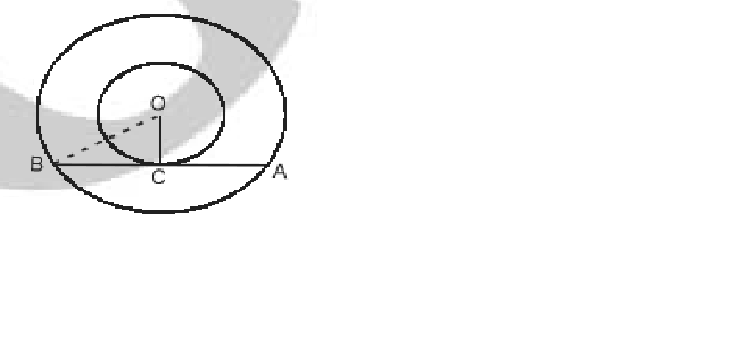
Ans .
(b) 12
- Explanation :
b It can be seen that every city is connected to all the other 3 cities. If we start from city A, there are 3 ways in which we can proceed, viz. AB, AD or AC. Once we are at any of these cities, each one of them is connected to the other 3 cities. But since we cannot go back to city A, there are only 2 ways in which we can proceed from here. If we are at B, we can take either paths BD or BC.

Ans .
(c) 15
- Explanation :
c Number of children, who did not try any of the rides = 85 – (x + y + z) = 85 – (15 + 35 + 20) = 15
Ans .
(c) 15
- Explanation :
c Number of children, who took exactly one ride = x = 15
Ans .
(b) Rs.2
- Explanation :
b The price of 1 mango is equal to the price of 2 oranges. Hence, 5 mangoes will be equivalent to 10 oranges. So 20 oranges cost Rs.40, therefore one orange will cost Rs.2.
Ans .
(a) 26
- Explanation :
a The following Venn diagram shows the distribution of numbers between 1 and 100 that are divisible by 2, 3, 5 or a combination of two or more of them.
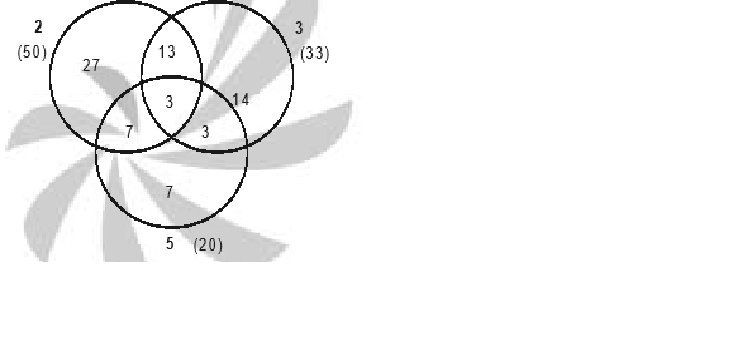 50 numbers are divisible by 2, 33 numbers are divisible by 3 and 20 numbers are divisible by 5. 3 numbers are divisible by all 2, 3 and 5. 16 numbers are divisible by both 2 and 3, therefore 13 numbers are divisible by 2 and 3 but not by 5. 10 numbers are divisible by both 2 and 5, therefore 7 numbers are divisible by 2 and 5 but not by 3. 6 numbers are divisible by both 3 and 5, therefore 3 numbers are divisible by 3 and 5 but not by 2.Total number of numbers that are divisible by one or more among 2, 3 and 5 = 27 + 14 + 7 + 13 + 3 + 7 + 3 = 74 Hence, the required number = 100 – 74 = 26.
50 numbers are divisible by 2, 33 numbers are divisible by 3 and 20 numbers are divisible by 5. 3 numbers are divisible by all 2, 3 and 5. 16 numbers are divisible by both 2 and 3, therefore 13 numbers are divisible by 2 and 3 but not by 5. 10 numbers are divisible by both 2 and 5, therefore 7 numbers are divisible by 2 and 5 but not by 3. 6 numbers are divisible by both 3 and 5, therefore 3 numbers are divisible by 3 and 5 but not by 2.Total number of numbers that are divisible by one or more among 2, 3 and 5 = 27 + 14 + 7 + 13 + 3 + 7 + 3 = 74 Hence, the required number = 100 – 74 = 26.
Ans .
(a) 1023
- Explanation :
a U0 = 2^0 – 1 = 0 U1 = 2^1 – 1 = 1 U2 = 2^2 – 1 = 3 U3 = 2^3 – 1 = 7 and so on. Hence, U10 = 2^10 – 1 = 1023.
Ans .
(a) even
- Explanation :
a f(x) = |x|^3 ∴ f(–x) = |–x|^3= |x|^3 = f(x). Hence, the given function is even.
Ans .
(b) is always an odd function
- Explanation :
b Let f(x) = g(x) + h(x), where g and h are odd functions. ∴ f(–x) = g(–x) + h(–x) = –g(x) – h(x) = –f(x). Hence, f(x) is an odd function.
Ans .
(a) 6666600
- Explanation :
a If we assume that any digit is in a fixed position, then the remaining four digits can be arranged in 4! = 24 ways. So each of the 5 digits will appear in each of the five places 24 times. So the sum of the digits in each position is 24(1 + 3 + 5 + 7 + 9) = 600. Hence, the sum of all such numbers will be 600(1 + 10 + 100 + 1000 + 10000) = 6666600.
Ans .
(c)\( \frac{1}{6} \)
- Explanation :
c Since there are 6 red balls and all six of them are of different sizes, probability of choosing the smallest among them is 1/6
Ans .
(b) 3 km east and √3 km north of A
- Explanation :
b Since ∆ ABC is an equilateral triangle with length of the side 2 km, so its altitude will be √3 km. As point D is directly east of C, so D is 3 km east and √3 km north of A.
Ans .
(d) 6 km
- Explanation :
d ABDC and AEBC, both are rhombus with each side 2 km. Hence, the total distance walked by the person = BD + DB + BE = 2 + 2 + 2 = 6 km.
Ans .
paste_right_option
- Explanation :
b Let l be the length of the rod, then Volume of slab = Volume of rod = 8 x 11 x 2 = π(8/2)^2 = l 3.5 ⇒= inches.
Ans .
(b) between 0 and 1
- Explanation :
b Since there are two numbers which are less than 1 (viz. x and y), it is obvious that the median will be less than 1. Hence, (c) cannot be the answer. Since x < 0.5 and 0 < y < 1, the median will not be less than 0. Hence, the answer is (b).
Ans .
(d) \( \frac{5}{16} \)
- Explanation :
d So maximum possible value will be at the point of intersection of the two graphs.

\( \frac{1}{3x^2} \)½- =\( \frac{〖5x〗^2}{4} \) = ⇒〖x〗^2 =\( \frac{1}{4} \) Hence, required maximum value= \( \frac{5x^2}{4} \)= \( \frac{1}{2} \)\( \frac{5}{4} \)* \( \frac{1}{4} \)=\( \frac{5}{16} \)
Ans .
(b)3
- Explanation :
b Let the work done by a worker be x units, w be the total work and n be the number of workers in the group. Then, w = Work done on the nth day i.e. last day + Work done on the second last day + … + Work done on the first day () n n+1 x w= x + 2x + ... + nx = 2 ⇒ … (i) When none of the workers is removed, then w = nx x 2n/3 = 2n^x/3 … (ii) From equation (i) and (ii), we get N( n+1)x/2 = 2n^2x/3 = n=3
Ans .
(c)8
- Explanation :
c We can form a triangle with any 3 points which are not collinear. 3 points out of 5 can be chosen in 5C3 = 10 ways. But of these, the three points lying on the two diagonals will be collinear. So 10 – 2 = 8 triangles can be formed.
Ans .
(c)40
- Explanation :
c Since each VCR owner also has a TV, therefore, 15 families own both TV and VCR but not Radio. Since 25 families have radio only, therefore, 10 families own both TV and Radio but not VCR. Hence, number of families having only TV = 75 – 10 – 10 – 15 = 40.
Ans .
(a)2
- Explanation :
a @(/(*(2, 4), 4), 2) = @(/(8, 4), 2) = @(2, 2) = 2.
Ans .
(a) *(@(A, B), 2)
- Explanation :
a A + B = 2((A + B)/2) = 2(@(A, B)) = *(@(A, B), 2).
Ans .
(a) *(@(*(@(B, A), 2), C), 3)
- Explanation :
a Sum of A, B, C =[A + B + C] = 3{[2((A + B)/2) + C] / 3} =*(@(*(@(B, A), 2), C), 3). (HINT : Students please note that for Q87 and Q88, if it doesn’t strike you to simplify in this manner, the best way is to simplify the answer choices and work backwards.)
Ans .
paste_right_option
- Explanation :
. a The total number of the characters = (20 x 55 x 65). Let the number of pages in the new format be n. Thus, the total number of the characters = (65 x 70 x n). Since the total number of the characters remains same, therefore, n 16. ≈ Hence, the required percentage = 20 - 16/20 x 100 = 20%
Ans .
(a)(x2 – z2) has to be positive.
- Explanation :
a Let us evaluate each option. Option (a): As x < 0 and z > 1, let x = – 1 and z = 3, then (x2 – z2) = – 8. Hence, this option is not true. Option (b): As 0 < y < 1 and z > 1, let 1 y 4 = and z = 2, then 11 yz 2 . 42 =×= Therefore, yz can be less than 1. Option (c): Since none of the x and y is equal to zero, therefore xy can never be zero. Option (d): 0 < y < 1 and z > 1, therefore (y2 – z2) is always negative. Hence, answer is (a).
Ans .
(b) index finger
- Explanation :
. b She counted thumb on 1, 9, 17, 25 and so on. So it forms an arithmetic progression. She counted thumb closest of 1994 on (1 + 1992 (multiple of 8)) = 1993 Hence, she would have counted 1994 on the index finger.
Ans .
(a) Closer to A
- Explanation :
a It is clear that after a particular amount of time P and Q are equidistant from A and B respectively and speed of Q is twice the speed of P, therefore, in the remaining time distance moved by Q will be twice than P. Hence, they would meet closer to A.
Ans .
(d) 12
- Explanation :
d Let the speed of P be x and the distance between A and B be d, so the speed of Q will be 2x. According to the question, () d 1 t v 2vt 6 +== (Let t be the travel time of Q) t 1 and d 12v ⇒ = = Hence, the time taken by P to reach to B d 12 hours. v
Ans .
(c) 6
- Explanation :
c As P takes 12 hours to complete his journey, so Q moving with twice the speed of P will take 12 6 2 = hours to complete his journey. Hence, P will take 6 hours more than Q to complete the journey.
Ans .
(d) 86
- Explanation :
d Required number = LCM (4, 6, 7) + 2 = 86.
Ans .
(c) more than 50%
- Explanation :
c It can be seen that if a spherical ball is placed inside a hollow cone of same diameter, the ball won’t go up to the diameter. In other words, because of the slanting edges of the cone, only less than 50% of the ball would enter the cone. i.e, more than 50% of the ball would be outside the cone.
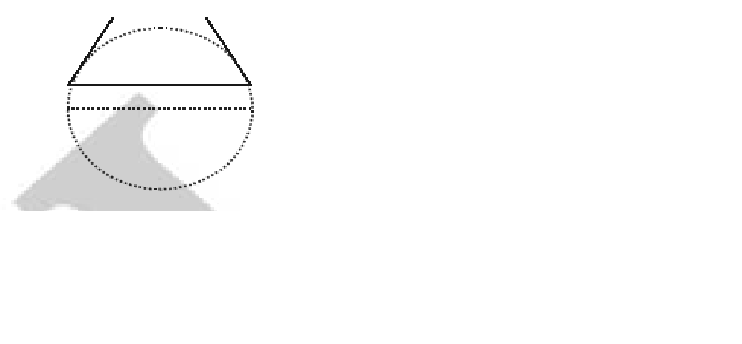
Ans .
(d) 20 miles
- Explanation :
d The separation between the ship and the seaplane is 18 miles. Since the two are travelling in the same direction, the relative speed would be 9 times the speed of the ship (If speed of ship is x miles/hour, speed of the seaplane would be 10x and 10x – x = 9x). Hence, to catch up with the ship, the seaplane would take 18 2 = hours. 9x x Now, the ship covers x miles in an hour, so in 2 x hours it would cover 2 miles. So when the seaplane catches up with the ship, it would be 18 + 2 = 20 miles from the shore.
Ans .
(b) 24
- Explanation :
b Number of 2 in the product of all integers from 1 to 100 100 100 100 100 100 100 2 4 8 16 32 64 =+++++ 50 25 12 6 3 1 97 = + + + + + = and number of 5 in the product of all integers from 1 to 100 100 100 5 25 =+ 20 4 24 = + = Hence, number of zeros at the end = Lowest of the (number of 2, number of 5) = 24.
Ans .
(d) 8
- Explanation :
d In this case since x, y and z are distinct positive integers, our aim is figure out which of the answer choices cannot be expressed as the sum of 3 integers uniquely. E.g. 6 can only be expressed as (1 + 2 + 3). 7 can only be expressed as (1 + 2 + 4). But 8 can be expressed as either (1, 2, 5) or (1, 3, 4).
Ans .
(b) Akbar
- Explanation :
. b Since Akbar likes rain, he cannot be a frisbee player (as no frisbee player likes rain). And since every boy in the school does one of the two, Akbar has to be a fisherman.
Ans .
(b) anomic suicide.
- Explanation :
b It is a manifestation of anomic suicide.
Ans .
(a) to document that suicide can be explained without reference to the individual.
- Explanation :
a Furkheim was trying to document the fact that something as individualistic as suicide can be explained without reference to individuals.
Ans .
(b) anomic suicide.
- Explanation :
b It is also a manifestation of anomic suicide.
Ans .
(c) egoistic suicide.
- Explanation :
c This was categorised as egoistic suicide.
Ans .
(d) All of the above.
- Explanation :
d Durkheim uses all three as explanations for suicide within a social entity.
Ans .
(a) military personnel than among civilians.
- Explanation :
a Military personnel, trained to lay their lives for the country are more likely to commit suicide.
Ans .
(b) vindicated on all counts.
- Explanation :
b Durkheim was successful on all three indicators that he based his contentions on.
Ans .
(d) All of the above.
- Explanation :
d He has used all the given indicators to support his contentions.
Ans .
(a) a manifestation of strong social integration.
- Explanation :
a This would happen due to a manifestation of strong individual ties.
Ans .
(a) some computer companies are expanding while others are contracting.
- Explanation :
a The passage shows that though IBM is losing ground in one market after another, Intel and Microsoft have emerged as the computer industry’s most fearsome pair of competitors.
Ans .
(c) IBM laying off workers in the biggest job cut in American corporate history.
- Explanation :
c IBM’s ‘loss’ and not the ‘lay off’ was the biggest in the corporate history.
Ans .
(b) IBM .
- Explanation :
b IBM marketed Ambra.
Ans .
(b) A new company went ahead of an established market leader.
- Explanation :
b General Motors, a relatively new company, had surpassed Ford as America’s No. 1 car maker.
Ans .
(d) Intel.
- Explanation :
d Intel was the major supplier of silicon chips to IBM.
Ans .
(c) all companies ultimately regret being a Dr. Frankenstein to some other company.
- Explanation :
c The passage states that each company feels threatened by its own creations.
Ans .
(a) IBM plans to introduce a new system that will run on a variety of machines.
- Explanation :
a The passage states that IBM plans to introduce a new system that would run on a variety of machines.
Ans .
(c) Microsoft.
- Explanation :
c Windows NT, developed by Microsoft will link together many computers through a network.
Ans .
(a) The two companies developed competing software’s.
- Explanation :
a Both marketed their own versions of Os2.
Ans .
(b) 70 percent of the total water available in the country is polluted.
- Explanation :
b NEERI has reported that 70% of the total water available in the country is polluted.
Ans .
(a) poor economic utilization of resources.
- Explanation :
a The degradation of natural resources will lead to poor economic utilization of resources.
Ans .
(c) Both (a) and (b).
- Explanation :
c W.H.O. has made both the observations.
Ans .
(d) All of the above are correct.
- Explanation :
d All the given statements are supported by the passage.
Ans .
(b) 75 percent of the Ganga’s water pollution load.
- Explanation :
b 75% of Ganga’s pollution comes from municipal sewage.
Ans .
(c) drying up of water sources and over pumping.
- Explanation :
c Drying up of water resources and over pumping causes drinking water crisis.
Ans .
(d) the US, UK, Netherlands, Poland, France, the World Bank and India.
- Explanation :
d US, UK, Netherlands, Poland, France, World Bank and India are together going to fund the project.
Ans .
(d) Ganga, Yamuna, Kali, Hindon, Cauvery and Kapila.
- Explanation :
d Ganga, Yamuna, kali, Hindon, cauvery and Kapila, have all shown great amounts of metal pollutants in their waters.
Ans .
(a) about 53 percent.
- Explanation :
a Out of a total outlay of 6,522.47 crores, rural water supply would receive 3,454.47 crores.
Ans .
(b) cleaning up polluted water.
- Explanation :
b The shortage can be best tackled by cleaning up polluted water.
Ans .
(c) physical, conceptual and emotional levels.
- Explanation :
c This task should operate at the physical, conceptual as well as at the emotional levels.
Ans .
(c) When space boundaries are violated, the quality of space suffers.
- Explanation :
c Violation of space boundaries makes the quality of space suffer, hence openness of space can be created only by the firmness of its boundaries.
Ans .
(d) All of the above reasons.
- Explanation :
d The author has given all three as reasons that make learning a painful process.
Ans .
(d) to extend the parallel of physical space to our experiences in daily life.
- Explanation :
d Our experiences in the physical world have parallels in our relationships with others, where the concept of space also works.
Ans .
(d) Where the teacher provides information and theories which open new doors and encourages students to help each other learn.
- Explanation :
d The author feels that a learning space would be one where the teacher provides information and theories which encourage the process of learning.
Ans .
(a) silence helps to unite us with others to create a community of truth.
- Explanation :
. a Silence unites us and we also become more open to truth.
Ans .
(c) An effective teacher recognizes the value of empathy.
- Explanation :
c An effective teacher would be one who is not afraid of dealing with feelings.
Ans .
(c) learning space to be filled by speed reading of several hundred pages of assigned reading.
- Explanation :
. c An effective teacher would never allow the learning space to be filled by reading of a big number of pages of assigned reading.
Ans .
(b) a teacher who is not afraid of confronting feelings.
- Explanation :
b An emotionally honest learning space is created by a teacher who is not afraid of dealing with feelings.
Ans .
(a) assigned reading and lecturing.
- Explanation :
a Assigned reading and lecturing can create a conceptual space.
Ans .
(b) Is highly productive and gives corporate leadership a long term view as a result of its strong traditions.
- Explanation :
b The author states that the harmony among these traditional elements has made Japanese industry highly productive and given corporate leadership a long term view.
Ans .
(d) a perception that it was a ‘passport to good life.’
- Explanation :
d It was widely perceived that management education was a passport to good life.
Ans .
(b) management education faced criticisms in the 1980’s
- Explanation :
b In 1980’s management education had started getting criticism from various quarters.
Ans .
(c) it was irrevocably irrelevant.
- Explanation :
c Management education faced all other criticisms in the 1980’s
Ans .
(a) is due to the prevalent belief that management ability can only be acquired over years of practical experience.
- Explanation :
a Japan has traditionally believed that management ability can only be acquired through years of practical experience
Ans .
(c) when management education gained new academic stature and greater respect.
- Explanation :
c In 1960’s and 1970’s management education gained academic stature. A management professor was even awarded the Nobel prize. It also gained more respect.
Ans .
(b) many critics felt the learning had little relevance to business problems.
- Explanation :
. b In 1980’s critics charged that learning had little relevance to real business problems.
Ans .
(b) sought the socialization of newcomers.
- Explanation :
b Training programmes in Japanese corporations have sought the socialization of new comers.
Ans .
(d) a combination of increased competitive pressures and greater multi-nationalisation of Japanese business.
- Explanation :
d Increased competitive pressures and greater multi nationalism of Japanese business made Japan change its attitude towards management education.
Ans .
(a) their highly developed and intensively competitive education system.
- Explanation :
a The author states that the Japanese educational system is highly developed and intensely competitive, raising the mathematical and literary capabilities of the Japanese to the highest in the world.
Ans .
(d) in the process of selecting and orienting new recruits
- Explanation :
d The two differ in their process of selecting and orienting new recruits.
Ans .
(a) Japanese do not do without business schools as is generally perceived.
- Explanation :
a The author has given the example of Wharton to argue that Japanese do not ‘do without’ business schools.
Ans .
(c) 1993
- Explanation :
c It is clear that the profit per rupee of equity is highest for 1993 viz. 0.64.
Ans .
(c) 1992 – 93
- Explanation :
c The simple annual growth rate in sales is maximum for the year 1992-93 viz. 20.75%.
Ans .
(b) 1991
- Explanation :
b Sales per rupee of the expenditure is lowest for the year 1991 viz. 1.04.
Ans .
(b) 1991
- Explanation :
b Sales per rupee of equity is highest for 1991 viz. 11.5
Ans .
(d) DAT
- Explanation :
d From the above table, it can be seen that the company that had the lowest sales is DAT viz. Rs.6 lakhs.
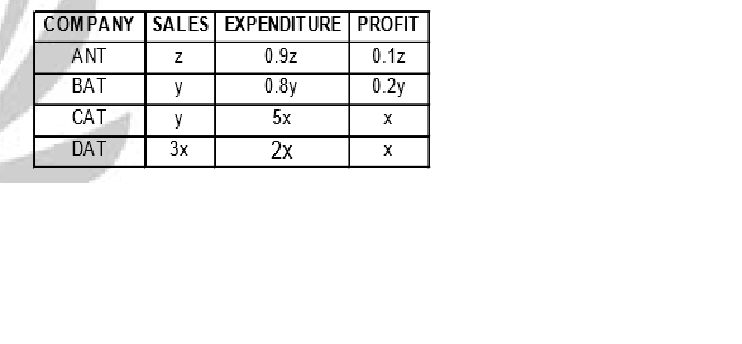 Now, it is said that the total expenses of CAT were Rs.10 lakhs. Thus, 5x = Rs.10 lakhs or x = Rs.2 lakhs. Also, total expenses of ANT were 10% less than those of CAT = Rs.9 lakhs. Hence, 0.9z = 9 lakhs or z = 10 lakhs. Finally, in case of CAT, since Sales – Expenditure = Profit, Sales = Expenditure + Profit = 6x = 12 lakhs, y = 12 lakhs. Our final table will become:
Now, it is said that the total expenses of CAT were Rs.10 lakhs. Thus, 5x = Rs.10 lakhs or x = Rs.2 lakhs. Also, total expenses of ANT were 10% less than those of CAT = Rs.9 lakhs. Hence, 0.9z = 9 lakhs or z = 10 lakhs. Finally, in case of CAT, since Sales – Expenditure = Profit, Sales = Expenditure + Profit = 6x = 12 lakhs, y = 12 lakhs. Our final table will become:

Ans .
(c) CAT
- Explanation :
c CAT had highest total expenses i.e., Rs.10 lakhs.
 Now, it is said that the total expenses of CAT were Rs.10 lakhs. Thus, 5x = Rs.10 lakhs or x = Rs.2 lakhs. Also, total expenses of ANT were 10% less than those of CAT = Rs.9 lakhs. Hence, 0.9z = 9 lakhs or z = 10 lakhs. Finally, in case of CAT, since Sales – Expenditure = Profit, Sales = Expenditure + Profit = 6x = 12 lakhs, y = 12 lakhs. Our final table will become:
Now, it is said that the total expenses of CAT were Rs.10 lakhs. Thus, 5x = Rs.10 lakhs or x = Rs.2 lakhs. Also, total expenses of ANT were 10% less than those of CAT = Rs.9 lakhs. Hence, 0.9z = 9 lakhs or z = 10 lakhs. Finally, in case of CAT, since Sales – Expenditure = Profit, Sales = Expenditure + Profit = 6x = 12 lakhs, y = 12 lakhs. Our final table will become:

Ans .
(a) ANT
- Explanation :
a ANT had lowest profits i.e., Rs.1 lakh.
 Now, it is said that the total expenses of CAT were Rs.10 lakhs. Thus, 5x = Rs.10 lakhs or x = Rs.2 lakhs. Also, total expenses of ANT were 10% less than those of CAT = Rs.9 lakhs. Hence, 0.9z = 9 lakhs or z = 10 lakhs. Finally, in case of CAT, since Sales – Expenditure = Profit, Sales = Expenditure + Profit = 6x = 12 lakhs, y = 12 lakhs. Our final table will become:
Now, it is said that the total expenses of CAT were Rs.10 lakhs. Thus, 5x = Rs.10 lakhs or x = Rs.2 lakhs. Also, total expenses of ANT were 10% less than those of CAT = Rs.9 lakhs. Hence, 0.9z = 9 lakhs or z = 10 lakhs. Finally, in case of CAT, since Sales – Expenditure = Profit, Sales = Expenditure + Profit = 6x = 12 lakhs, y = 12 lakhs. Our final table will become:

Ans .
(b) BAT
- Explanation :
b BAT had the highest profits i.e., Rs.2.4 lakhs
 Now, it is said that the total expenses of CAT were Rs.10 lakhs. Thus, 5x = Rs.10 lakhs or x = Rs.2 lakhs. Also, total expenses of ANT were 10% less than those of CAT = Rs.9 lakhs. Hence, 0.9z = 9 lakhs or z = 10 lakhs. Finally, in case of CAT, since Sales – Expenditure = Profit, Sales = Expenditure + Profit = 6x = 12 lakhs, y = 12 lakhs. Our final table will become:
Now, it is said that the total expenses of CAT were Rs.10 lakhs. Thus, 5x = Rs.10 lakhs or x = Rs.2 lakhs. Also, total expenses of ANT were 10% less than those of CAT = Rs.9 lakhs. Hence, 0.9z = 9 lakhs or z = 10 lakhs. Finally, in case of CAT, since Sales – Expenditure = Profit, Sales = Expenditure + Profit = 6x = 12 lakhs, y = 12 lakhs. Our final table will become:

Ans .
(b) 12%
- Explanation :
b The growth rate of total assets between 1990-93
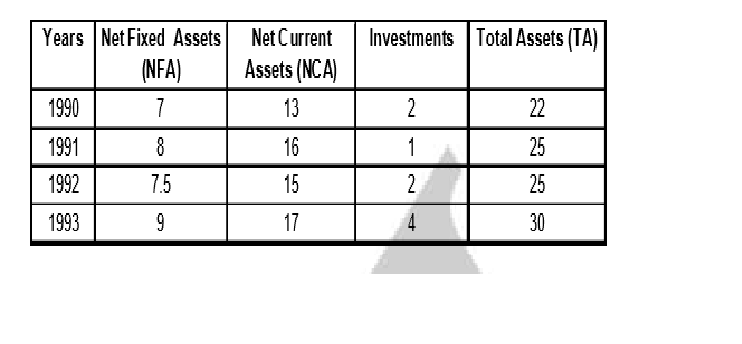 (30 – 22) = = 36%. 22
But this is for a 3 year period.
Hence, simple average annual growth rate =
36 3
= 12%.
(30 – 22) = = 36%. 22
But this is for a 3 year period.
Hence, simple average annual growth rate =
36 3
= 12%.
Ans .
(c) Investments
- Explanation :
c It can be seen that the growth rate is lowest for investments in 1990-91 viz. 50% decrease.

Ans .
(c) Investments
- Explanation :
c Between 1991 and 1992, the highest growth rate was seen for investments viz. 100% increase

Ans .
(d) Total Assets.
- Explanation :
d It can be seen that every individual item has shown a decrease in some year or the other. Only Total Assets has not followed this trend. For question 163 to 166: Since Soumya was the last one to eat the cookies and she ate 3 cookies, the total number of cookies left when she entered the room = (3 × 4) = 12. This should be Soumya’s share that was left in the box uneaten. Hence, just before Soumya entered, Swetha, Sneha and Swarna would have eaten their share of 12 cookies each. Total number of cookies left when Sneha entered = (12 × 4) = 48. This in turn should have been the combined share of Sneha and Soumya (24 × 2) that was left in the box uneaten. So just before Sneha entered, Swetha and Swarna should have eaten 24 cookies each. In other, words number of cookies left, just before Swarna entered = (24 × 4) = 96. Now this should have been the combined share of Swarna, Sneha and Soumya (3 × 32) that was kept in the box by Swetha . So just before Swarna entered, Swetha must have eaten her share of 32 cookies. Hence, total number of cookies given by Prem uncle = (32 × 4) = 128. The situation is also shown in the following table:

Ans .
(c) 15
- Explanation :
c Sneha ate 15 cookies, in total.
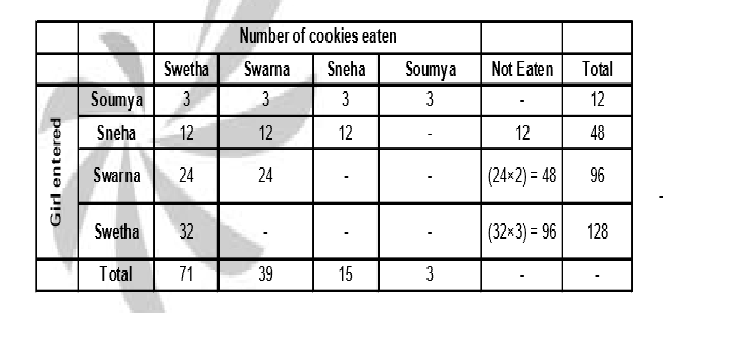
Ans .
(a) 128
- Explanation :
a Prem uncle gave 128 cookies to Swetha.

Ans .
(d) 71
- Explanation :
d Swetha ate 71 cookies, in total.

Ans .
(c) 39
- Explanation :
c Swarna ate 39 cookies, in total.

Ans .
(a) 0
- Explanation :
a Number of students who were both female and excellent = 0.
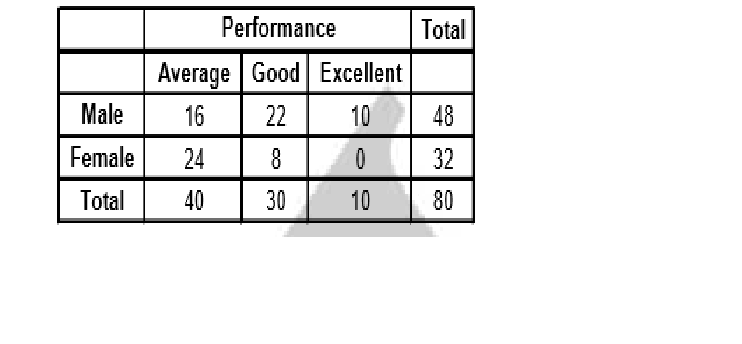
Ans .
(c) 22
- Explanation :
c Number of students who were both male and good = 22.
Ans .
(d) 2 : 3
- Explanation :
d Ratio of male to female among average students = 16 : 24 = 2 : 3.
Ans .
(b) 0.25
- Explanation :
b Proportion of female students who were good 8 = = 0.25.
Ans .
(b) 0.73
- Explanation :
b Proportion of good students who are male 22 = = 0.73.
Ans .
(b) Petroleum & Solid Fuels
- Explanation :
b Thus, we can see that Solid Fuels and Petroleum together constitute more than 60% of total energy in both World and Asia for the given period.
Ans .
(a) Petroleum
- Explanation :
a As seen from the above table, Petroleum is the fuel whose proportion in the total energy demand increases during 19902000 and decreases during 2000-2010 for both World and Asia.
Ans .
">(d) Hydropower
- Explanation :
d In case of Asia, for the given answer choices, we can make the following table
Ans .
(d) Natural Gas
- Explanation :
d In case of the World, for the answer choices, we can make the following table. Hence, we can see that the proportion of Nuclear gas in total energy demand of the World remains constant over the given period and its proportion will increase in the total energy demand in Asia. (Use information of the question number 174.)
